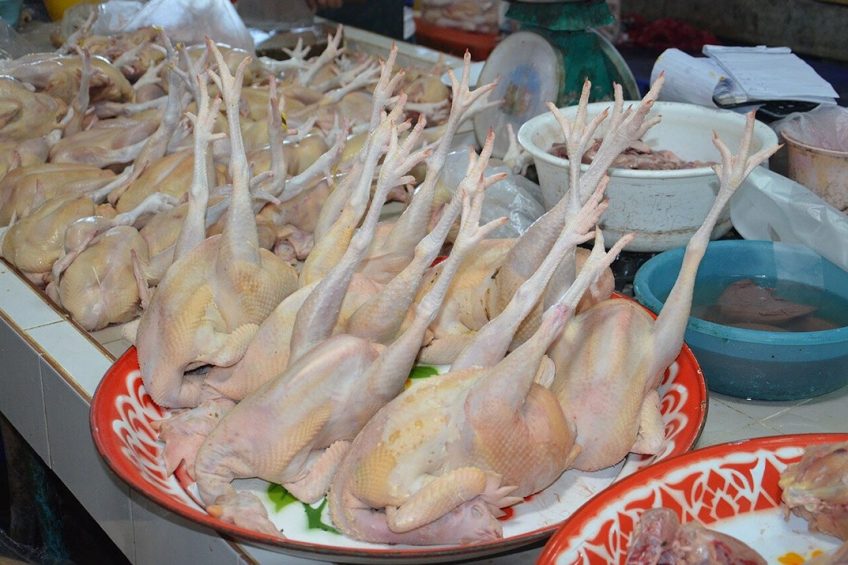Thailand: Poor demand, chicken inventory record

Despite being the most popular meat in Thailand, chicken meat demand has been severely affected as a consequence of the Covid-19 pandemic.
The pandemic has caused a record economic contraction, and a sharp decline in the number of tourists visiting the country. A record high inventory of chicken meat has resulted.
Chicken meat is the most popular meat for Thai consumers, who prefer dark chicken meat to white meat. In 2019, the estimated consumption per capita was 28-29kg. In 2020, domestic consumption of chicken meat, which accounts for about 70% of total chicken meat production, is expected to decline by 4-5%. Consumption declined by 2-3% between January and July 2020. As a result of the Covid-19 pandemic, a record economic contraction of 8.1% is expected in Thailand, and the service sector, which accounts for 27% of the Thai economy, has been one of the sectors that was hit the hardest. The hotel and restaurant sector declined by 46% in the second quarter of 2020, with the total number of tourists expected to decline from almost 40 million in 2019 to just 8 million in 2020. Chicken meat consumption further declined by 3-4% in the second quarter of 2020.
Production decline
Due to the reduced consumption of chicken, broiler meat production in 2020 is expected to decline 1-2% from 2019. In 2021, broiler chicken meat production is forecast to increase 2-3% from 2020 in anticipation of a gradual recovery in domestic demand and exports of cooked chicken meat. An anticipated further increase in uncooked chicken meat exports to China will also help maintain broiler chicken production growth in 2021. In Thailand, chick production capacity from both vertically integrated processors and independent breeders is estimated at about 40 million birds/week.
 Poultry bones turned into green fuel
Poultry bones turned into green fuel
Brazilian researchers are looking into the possibility to turn poultry bone waste into a green biodiesel via hydrogenation.
Increasing feed costs
Broiler farming faces high and increasing production costs, which, in 2020, are estimated to increase 2-3% from 2019, reaching approximately 34-35 baht (US$ 1.09-1.12) per kg live broiler weight. Feed costs (60-65% of production costs of live broilers) remain high due to the government’s market intervention programmes such as the price guarantee programme for corn, the domestic absorption of corn tied to feed wheat imports, and tariff barriers on DDGS.
Record high, rising inventory
Reduced domestic consumption resulted in a record high inventory of chicken meat in the first quarter of 2020, which had increased approximately 60% from the same period in 2019. Stocks continued rising throughout the pandemic building on inventories that were already 40% higher than last year in January 2020, to inventories 90% higher than last year in April 2020. Chicken meat processors lowered selling prices in the domestic market to stimulate demand. In August 2020, retail prices of both boneless breast meat and leg-quarters were down about 7-10% from the same period in 2019. In 2021, domestic consumption of chicken meat is forecast to increase by 2-3% from 2020 in line with gradual economic recovery. The Thai economy is expected to grow by 5% in 2021 driven by an anticipated increase in tourists.
 5 top actions to prepare for winter avian flu
5 top actions to prepare for winter avian flu
Due to fears about the possible spread of bird flu by migrating birds from Russia and Kazakhstan, UK Chief Veterinary Officers have taken action.
Half a million mt of meat exported
A total of 492,381 mt of chicken meat (excluding chicken paws) were exported between January and July 2020, down 1% from the same period in 2019. The growth in uncooked chicken meat exports was offset by reduced exports of cooked products. Exports of cooked chicken meat products, which account for 64% of total chicken meat exports, declined 6% from the same period in 2019 due mainly to shrinking demand from the EU. Cooked chicken meat exports to the EU declined 15-30%, while exports of uncooked chicken meat products (excluding paws), which account for 36% of total chicken meat exports, increased 7%, driven by a continued surge in exports to China.
China drives exports
In total, chicken meat exports (excluding paws) in 2020 are expected to increase 1% from 2019. Exports of uncooked chicken meat (excluding paws) to China between January and July 2020 totaled 48,594 mt, up 55% from the same period in 2019. China is still recovering from an outbreak of African Swine Fever in August 2018 that has reduced its local supply of pork meat. Chinese consumers are substituting pork meat for chicken meat, thereby increasing demand for uncooked chicken products from Thailand. Additionally, the number of Thai chicken meat export facilities eligible to export to China will increase to 21 in 2020, up from 14 in 2019.
Exports to China are expected to continue to increase for the remainder of 2020, and more chicken meat export facilities out of the total of 30 export facilities in Thailand are expected to be approved by the Chinese government next year, when uncooked chicken meat exports to China are expected to reach over 100,000 mt. Total chicken meat exports are forecast to grow by 3-4% in 2021, in line with a gradual recovery in the global economy after the Covid-19 outbreak.
The information in this article was compiled from a USDA GAINS report prepared by Ponnarong Prasertsri.












